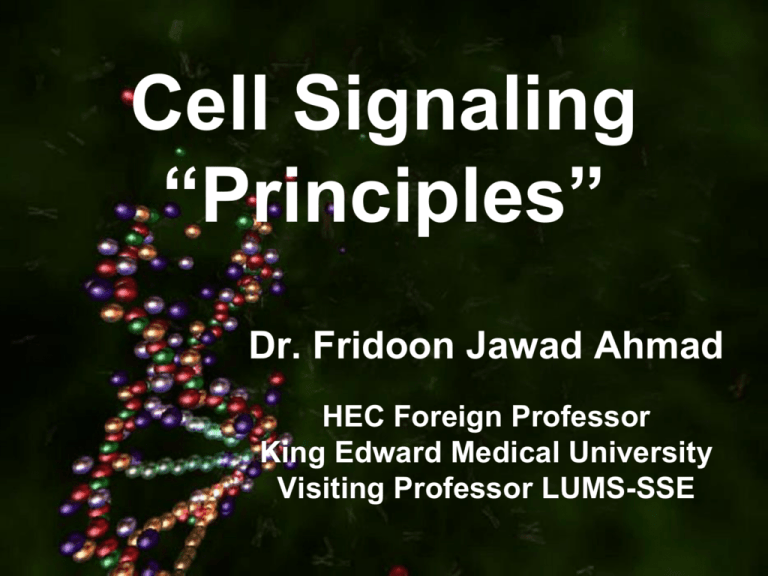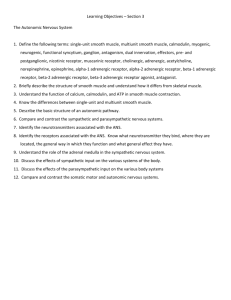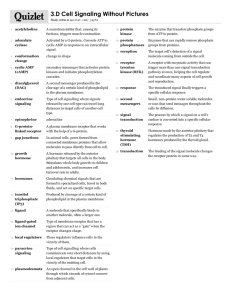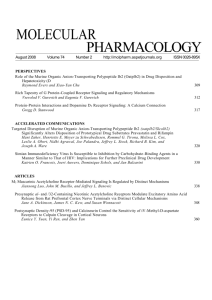Cell Signaling Principles (Prof. Fridoon)
advertisement

Cell Signaling “Principles” Dr. Fridoon Jawad Ahmad HEC Foreign Professor King Edward Medical University Visiting Professor LUMS-SSE 2nd Biggest Leap 2.5 billion Years Multicellular = Specialization = Coordination Ability to sense & respond to external and internal environment Why Signaling System In order to survive even simplest organisms need to sense and respond to their environment. It is critical that the cells of multicellular organisms communicate to coordinate their efforts (Running). Cells in a multicellular organism are specialized and rely on each other for the support (brain sugar). During development there have to be checks balances on differentiation (analogy society). Signals Can Instruct Cells to Perform Various functions (Manipulating Gene expression) Design 1) Ligand binding 2) Conformational change Cytoplasmic domain 3) Mediators 4) Cell function modified Expression of One Gene Can Alter Phenotype of Cells Modes Low Affinity Receptors & Cell Machinery Receptor combinations confer cell behavior in an environment flooded with hundreds of ligands Cellular machinery specifies cell response to a particular ligand High Turnover (NO) Ach NO Receptor-ACh NO synthase Deamination Diffusion G-cyclase cGMP Relaxation NO half life 5 seconds Receptors: Intracellular (ICR) Small Hydrophobic Lipid soluble molecules eg steroid & thyroid hormones, retinoids & Vit D etc Blood transport via carrier proteins longer life (thy days Ach ms) Carrier left outside Inactive ICR may be DNA bound or in cytoplasm (NLS nonfunctional) Activated receptor binds DNA induces gene transcription ICR Specificity Different cells with identical ICRs regulate different genes due to other cell specific mediators Right combination of co-activators/gene regulators required to transcribe specific genes (testosterone) ICR Transcription Ligand binding removes inhibitory proteins and facilitates binding of transcription activators Cell-Surface Receptors (CSR) CSR Response Time Neurotransmitters produce all or noting response Small IC Mediators SICMs are produced/released in response to signal received by the receptor SICMs donot have an enzymatic activity of their own however they modify the function of other molecules IC Proteins 1 3 6 4&5 7 2 1 Relay proteins simply pass the message to the next signaling component in the chain. 2 Messenger proteins carry the signal from one part of the cell to another, such as from the cytosol to the nucleus. 3 Adaptor proteins link one signaling protein to another, without themselves conveying a signal. 4 Amplifier proteins, which are usually either enzymes or ion channels, greatly increase the signal they receive, either by producing large amounts of small intracellular mediators or by activating large numbers of downstream intracellular signaling proteins. When there are multiple amplification steps in a relay chain, the chain is often referred to as a signaling cascade. 5 Transducer proteins convert the signal into a different form. The enzyme that makes cyclic AMP is an example: it both converts the signal and amplifies it, thus acting as both a transducer and an amplifier. 6 Bifurcation proteins spread the signal from one signaling pathway to another. 7 Integrator proteins receive signals from two or more signaling pathways and integrate them before relaying a signal onward. 8 Latent gene regulatory proteins are activated at the cell surface by activated receptors and then migrate to the nucleus to stimulate gene transcription. Signaling in E. coli After ligand binding change in tertiary structure of extra cellular part of EnvZ leads to structural change in its cytoplasmic domain making it a kinase (auto..). EnvZ-P can now phosphorilate OmpR (responder) outside signal in and amplified. Signaling in E. coli Receptor conformational change after ligand binding which activates kinase activity. Phosphorilation alters responder function. Signal amplified. Transcription factor activated. Protein synthesis results in altered cell activity. G Protein-Linked Receptors Ligand binding causes a structural change permitting G protein to bind receptor. Binding of G protein to activated receptor causes it to exchange GDP for GTP (receptor releases ligand). G Protein-Linked Receptors Subunit of G protein separates and activates an effector molecule (causing a functional change). Epinephrine effects different cells differently (heart muscle contracts, intestinal vascular smooth muscle relaxes more nutrients absorbed (Adnl C inhibition). Second Messenger Second messengers are allosteric regulators and do not have enzymatic activity Cyclic AMP (cAMP) can bind ion channels to open them or bind enzymes to exposing their active sites. Enzyme Activation Via Second messenger The cAMP-dependent protein kinases (PKA) are tetramers, consisting of two regulatory (R) subunits and two catalytic (C) subunits. In the tetrameric form PKA is enzymatically inactive. Binding of cAMP to the R subunits causes dissociation of the two C subunits, which then can phosphorylate specific acceptor proteins. cAMP-dependent protein kinase (cAPK), glycogen phosphorylase kinase (GPK), and glycogen phosphorylase (GP) — are all regulated, directly or indirectly, by cAMP by phosphoprotein phosphatase, which removes the phosphate residues from the inactive form of glycogen synthase At high cAMP levels, cAPK phosphorylates an inhibitor of phosphoprotein phosphatase (PP) CRE Gs vs Gi PKC Activation via Gq Cell type Organ/system Activators ligands --> Gq-GPCRs Effects smooth muscle cell (gastrointestinal tract sphincters) digestive system •prostaglandin F2α[4] --> •thromboxanes[4] contraction •smooth muscle cells in:iris dilator muscle (sensory system) •urethral sphincter (urinary system) •uterus (reproductive system) •arrector pili muscles(integumentary system) •ureter (urinary system) •urinary bladder (urinary system)[5][6] Various •adrenergic agonists --> α1 receptor contraction •smooth muscle cells in:iris constrictor muscle •ciliary muscle sensory system acetylcholine --> M3 receptor contraction smooth muscle cell (vascular) circulatory system •5-HT --> 5-HT2A receptor •adrenergic agonists --> α1 receptor •vasoconstriction[7][8] smooth muscle cell (seminal tract[9]) reproductive system •adrenergic agonists --> α1 receptor ejaculation smooth muscle cell (GI tract) digestive system •5-HT --> 5-HT2A or 5-HT2B receptor[7] •acetylcholine (ACh) --> M3 receptor •contraction[10] smooth muscle cell (bronchi) respiratory system •5-HT --> 5-HT2A receptor •adrenergic agonists --> α1 receptor •acetylcholine --> M3[11] andM1 receptor[12] bronchoconstriction[7] proximal convoluted tubule cell kidney •angiotensin II --> AT1 receptor •adrenergic agonists --> α1 receptor •stimulate NHE3 --> H+ secretion & Na+ reabsorption[13] •stimulate basolateral Na-K ATPase --> Na+ reabsorption[13] neurons in autonomic ganglia nervous system acetylcholine --> M1 receptor EPSP neurons in CNS nervous system •5-HT --> 5-HT2A receptor •acetylcholine --> M1 receptor •neuronal excitation (5-HT)[7] •memory? (acetylcholine)[14] platelets circulatory system 5-HT --> 5-HT2A receptor[7] aggregation[7] ependymal cells (choroid plexus) ventricular system 5-HT --> 5-HT2C receptor[7] heart muscle circulatory system •adrenergic agonists --> α1 receptor positive ionotropic effect[5] serous cells (salivary gland) digestive system •acetylcholine --> M1 andM3 receptors •adrenergic agonists --> α1 receptor •↑secretion[5] •increase salivary potassium levels. serous cells (lacrimal gland) digestive system •acetylcholine --> M3 receptor •↑secretion[8] adipocyte digestive system/endocrine system •adrenergic agonists --> α1 receptor •glycogenolysis andgluconeogenesis[5] hepatocyte digestive system •adrenergic agonists --> α1 receptor •glycogenolysis andgluconeogenesis[5] sweat gland cells integumentary system •adrenergic agonists --> α1 receptor •↑secretion[5] parietal cells digestive system acetylcholine --> M1 receptors[12] ↑ gastric acid secretion ↑cerebrospinal fluid secretion[7] Receptor Tyrosine Kinases & Ras Autophosphorylation Activated RTKs Indirectly Bind and Activate RAS RAS Helpers Protein Kinase Cascade Signal Amplification Ras Experiment Alternate Names Comparison









